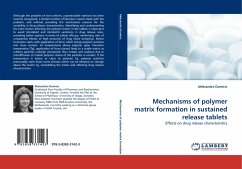Although the problem of non-uniform, unpredictable matrices has been recently recognised, a limited number of literature reports deals with the problem, and without providing the mechanistic reasons for the variability in drug release characteristics. Identifying and understanding the main factors affecting the polymer matrix in the tablets is important to avoid intratablet and intrabatch variations in drug release rates, providing better systems in terms of safety/ efficacy, minimising risks of unexpected release of high amounts of drug (dose dumping). Matrix formation starts with application of force which brings polymer particles into close contact. At temperatures above polymer glass transition temperature (Tg), application of force (stress) leads to a stable matrix as rubbery particles undergo viscoelastic flow (creep) and coalesce due to interdiffusion of mobile polymer chains of the particles in contact. If the temperature is below or close to polymer Tg, polymer particlespresumably store (lock) some stresses which can be released on storage above the matrix Tg, remodelling the matrix and affecting drug release characteristics.
Bitte wählen Sie Ihr Anliegen aus.
Rechnungen
Retourenschein anfordern
Bestellstatus
Storno








